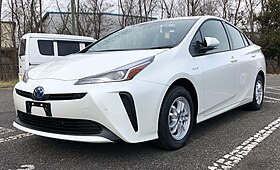Our website is made possible by displaying online advertisements to our visitors.
Please consider supporting us by disabling your ad blocker.
Green vehicle

| Part of a series on |
| Sustainable energy |
|---|
 |
A green vehicle, clean vehicle, eco-friendly vehicle or environmentally friendly vehicle is a road motor vehicle that produces less harmful impacts to the environment than comparable conventional internal combustion engine vehicles running on gasoline or diesel, or one that uses certain alternative fuels.[3][4] Presently, in some countries the term is used for any vehicle complying or surpassing the more stringent European emission standards (such as Euro6), or California's zero-emissions vehicle standards (such as ZEV, ULEV, SULEV, PZEV), or the low-carbon fuel standards enacted in several countries.[5]
Green vehicles can be powered by alternative fuels and advanced vehicle technologies and include hybrid electric vehicles, plug-in hybrid electric vehicles, battery electric vehicles, compressed-air vehicles, hydrogen and fuel-cell vehicles, neat ethanol vehicles, flexible-fuel vehicles, natural gas vehicles, clean diesel vehicles, and some sources also include vehicles using blends of biodiesel and ethanol fuel or gasohol.[4][6] In 2021, with an EPA-rated fuel economy of 142 miles per gallon gasoline equivalent (mpg-e) (1.7 L/100 km), the 2021 Tesla Model 3 Standard Range Plus RWD became the most efficient EPA-certified vehicle considering all fuels and all years, surpassing the 2020 Tesla Model 3 Standard Range Plus and 2019 Hyundai Ioniq Electric.[7]
Several authors also include conventional motor vehicles with high fuel economy, as they consider that increasing fuel economy is the most cost-effective way to improve energy efficiency and reduce carbon emissions in the transport sector in the short run.[8] As part of their contribution to sustainable transport, these vehicles reduce air pollution and greenhouse gas emissions, and contribute to energy independence by reducing oil imports.[4][8]
An environmental analysis extends beyond just the operating efficiency and emissions. A life-cycle assessment involves production and post-use considerations. A cradle-to-cradle design is more important than a focus on a single factor such as energy efficiency.[9][10]
- ^ Millikin, Mike. "Worldwide sales of Toyota hybrids surpass 9 million units; Prius family accounts for 63%". Green Car Congress. Retrieved 2016-05-22. The Prius family accounts for 63% of Toyota's total global cumulative hybrid car sales: 5.691 million units, consisting of Prius liftback: 3.733 million; Aqua, Prius c: 1.249 million; Prius α, Prius v, Prius +: 0.634 million; Prius PHV: 75,000.
- ^ Maynard, Micheline (2007-07-04). "Say 'Hybrid' and Many People Will Hear 'Prius'". New York Times. Retrieved 2013-07-03.
- ^ R.I.C. Publications (2005). Rainforests. R.I.C. Publications. p. 67. ISBN 978-1-74126-330-5.
- ^ a b c "Green Vehicle Guide". Green Student U. Archived from the original on 2013-12-03. Retrieved 2010-04-24.
- ^ Organisation for Economic Co-operation and Development, Organisation for Economic Co-operation and Development. Working Group on Low-Emission Vehicles (2004). Can cars come clean?. OECD Publishing. pp. 84–85. ISBN 978-92-64-10495-2.
- ^ "Alternative and Advanced Vehicles". Alternative Fuels and Advanced Vehicle Data Center, U.S. Department of Energy. Retrieved 2010-04-24.
- ^ Cite error: The named reference
EPAMost2017was invoked but never defined (see the help page). - ^ a b Sperling, Daniel; Deborah Gordon (2009). Two billion cars: driving toward sustainability. Oxford University Press, New York. pp. 235–260. ISBN 978-0-19-537664-7. See Chapter 9: Driving Towards Sustainability
- ^ Strategies for Managing Impacts from Automobiles, US EPA Region 10, retrieved May 22, 2012
- ^ "European Union's End-of-life Vehicle (ELV) Directive", End of Life Vehicles, EU, retrieved May 22, 2012
Previous Page Next Page


